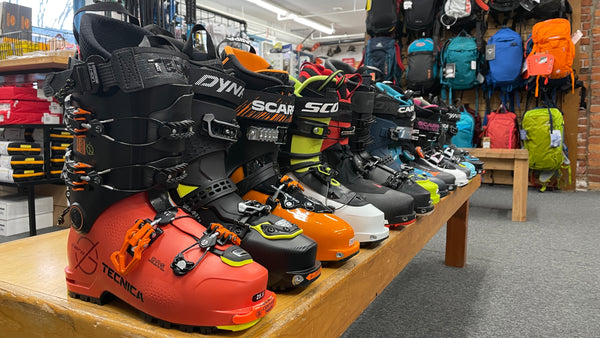
Ski Boot Guide: What Style Of Ski Boot Is Right For You
This article covers the differences between Backcountry (Alpine Touring) ski boots and downhill boots, as well as the different styles of Alpine Touring boots and how to choose the boot that's right for your activity.
And this video is basically just a condensed version of the article with everyone's fav Master bootfitter, Jerry.
Types of Alpine ski boots
Downhill and Alpine Touring (AT). Downhill boots are designed for use at ski areas where a lift is required to get up the hill. Alpine touring boots, also called backcountry boots, are designed to allow you to ski uphill, and therefore explore the backcountry sans ski lifts.The primary difference between these two types of boots is that an alpine touring boot has a releasable cuff.


By pulling up on the lock mechanism at the back of an AT boot, the whole cuff is released. This enables you to move your ankle and lower leg in a more normal walking motion, allowing you to efficiently ski uphill.
The other differentiator is the tech fittings. At the toe of an AT boot, there are little pin holes called tech fittings that interface with typical alpine touring bindings.

All ski boots (AT and Downhill) are designed with the capability to ski downhill, so all of these ski boots can be used inbounds at a ski resort assuming they are matched with an appropriate compatible binding. However, each individual ski boot is designed to perform best in a specific set of conditions. This article will break down how to tell which boots are best for which conditions.
Downhill boots
If you're skiing solely at a ski area your focus is likely to get the best downhill performance possible. Because of this, downhill boots are made heavier and stiffer than AT boots in order to provide more stability and better edge hold on firmer snow conditions. Inbound areas see a lot more skier traffic than the backcountry, so downhill boots are designed for the packed down snow that results from grooming and/or skier compaction.
Downhill boots come in a variety of different “flexes” or “stiffness” which are designated by the flex number of a boot (higher numbers = stiffer flex). Heavier or more aggressive skiers will usually prefer a stiffer boot for greater edge sensitivity and power transmission. Conversely, lighter weight or less aggressive skiers usually prefer a softer flex so that they can more easily engage the dynamic properties of the boot.
Keep in mind that there is no independent agency testing flex numbers on boots. This results in somewhat subjective numbering, i.e. a 130 flex by one manufacturer may be stiffer than a 130 flex boot by a different manufacturer.
Alpine touring (AT) boots or backcountry boots
The differences in AT boots basically come down to flexibility, weight, and range of motion. When looking at buying backcountry boots, you want to consider a number of questions:
- Where do you like to ski? (steep terrain, gentle glades, long multi-day tours, short and steep descents, etc.)
- How much force do you generate while turning? (This is a property of your weight and skiing style)
- How soft is the snow you will be skiing in and what type of skis will you be using? (heavy, fat boards in deep, mid-winter snow or light-weight skis on spring corn snow)
The answers to these questions will give you an idea of what type of flex to look for in a boot. In general, the stiffer and heavier the boot the better for skiing downhill, the lighter and more flexible the boot the better for climbing uphill. The stiffness of a boot will also feel different depending on how much you weigh. If you weigh 100lbs, a more flexible boot will provide you with the same amount of support and restriction as a stiffer boot will provide to a 200lb person. Lastly, bigger heavier skis require bigger heavier boots. So if you are really in love with your fat sticks, an ultra-light touring boot will make those skis harder to control.
Let’s look at the three basic subcategories of AT boot.
Performance Alpine Touring Boots
The performance alpine touring boot will give you the same, or very close to the same performance of a downhill boot. If you are looking to maximize your downhill performance when you're in the backcountry, this is your boot. These boots are stiffer, and sometimes they're also a little heavier.
The main distinction here is that a performance AT boot gives you a similar feeling to a downhill boot while still having the ability to ski uphill. They're often not quite as efficient on the uphill due to heavier weight and more limited range of motion as the other two categories of alpine touring boots, but that is a necessary trade-off to achieve the highest quality downhill performance.
These boots also perform really well in downhill areas and have the added bonus of being less awkward to walk in from the lodge to the ski lift because of the “walk-mode” that the releasable cuff provides. Thus, they work well as “crossover” boots between the lifts and backcountry.
All-round Alpine Touring Boots
The most popular category of Alpine Touring boots.
All-round AT boots are slightly softer flexing than performance AT boots. They also tend to have a bit more range of motion in the upper cuff and they are generally lighter weight than performance AT boots. This makes the uphill experience more efficient while still providing good performance on the downhill in all backcountry conditions.
This type of boot may also be appropriate for someone who's lighter weight or someone who wants more of a soft snow focused ski boot.
Ultra-light Alpine Touring Boots
Ultra-lightweight AT boots are great for doing long tours that require maximum uphill efficiency. They excel at multi-day tours, spring tours, and alpine climbs, and can rival the walkability and technical performance of an alpine climbing boot.
Ultra-light AT boots certainly have the performance needed to ski downhill well, but not in all snow conditions and not with all skis. Because their upper cuffs are softer and much more flexible, they are not going to have the same level of performance as stiffer boots. With these boots, you won’t be able to drive heavier skis, and especially not in challenging snow conditions. To get the best performance possible out of this boot, we recommend matching this boot to a lighter-weight ski, and be sure to consider the terrain and conditions you are planning to ski in.

